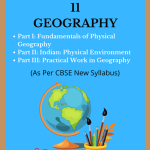NCERT Class 11 Geography Chapter 3 Interior of The Earth Solutions to each chapter is provided in the list so that you can easily browse through different chapters NCERT Class 11 Geography Chapter 3 Interior of The Earth and select need one. NCERT Class 11 Geography Chapter 3 Interior of The Earth Question Answers Download PDF. NCERT Geography Class 11 Solutions.
NCERT Class 11 Geography Chapter 3 Interior of The Earth
Also, you can read the NCERT book online in these sections Solutions by Expert Teachers as per Central Board of Secondary Education (CBSE) Book guidelines. CBSE Class 11 Geography Solutions are part of All Subject Solutions. Here we have given NCERT Class 11 Geography Part I: Fundamentals of Physical Geography, Part II: Indian: Physical Environment, Part III: Practical Work in Geography. NCERT Class 11 Geography Chapter 3 Interior of The Earth Notes, NCERT Class 11 Geography Textbook Solutions for All Chapters, You can practice these here.
Interior of The Earth
Chapter: 3
GEOGRAPY [ PART – I ]
TEXTUAL QUESTIONS ANSWERS
MULTIPLE CHOICE QUESTIONS
1. Which one of the following earthquake waves is more destructive?
(a) P-waves.
(b) S-waves.
(c) Surface waves.
(d) None of the above.
Ans. (a) P-waves.
2. Which one of the following is a direct source of information about the interior of the earth?
(a) Earthquake waves.
(b) Volcanoes.
(c) Gravitational forces.
(d) Earth magnetism.
Ans. (d) Earth magnetism.
3. Which type of volcanic eruptions have caused Deccan Trap formation?
(a) Shield.
(b) Flood.
(c) Composite.
(d) Caldera.
Ans. (b) Flood.
4. Which one of the following describes the lithosphere?
(a) upper and lower mantle.
(b) crust and upper mantle.
(c) crust and core.
(d) mantle and core.
Ans. (b) crust and upper mantle.
5. The vibration direction parallel to the wave direction in the vertical plane is present in
(a) P-waves.
(b) S-waves.
(c) Surface waves.
(d) L-wave.
Ans. (a) P-waves.
6. The interior of the earth can only be understood by _____________.
(a) Direct methods.
(b) Indirect methods.
(c) Both the indirect and direct methods.
(d) None of the Above.
Ans. (c) Both the indirect and direct methods.
7. Which is not a type of volcano?
(a) Shield volcano.
(b) Composite volcano.
(c) Ridge volcano.
(d) Caldera.
Ans. (c) Ridge volcano.
8. Volcanoes are
(a) indirect source of information about the earth’s interior.
(b) direct source of information about the interior of the earth.
(c) not a source of information about the interior of the earth.
(d) good source to ascertain earth’s temperature.
Ans. (b) direct source of information about the interior of the earth.
9. Which one of the following describes the lithosphere?
(a) Upper and middle mantle.
(b) Crust and upper mantle.
(c) Crust and core.
(d) Mantle and core.
Ans. (b) Crust and upper mantle.
10. The magnitude of an earthquake is measured in
(a) Richter Scale.
(b) Mercalli scale.
(c) Measuring scale.
(d) Seismograph.
Ans. (a) Richter Scale.
11. Magma refers to ______________.
(a) Rocks.
(b) Material in the upper mantle.
(c) Material in the upper core.
(d) Material in the crust.
Ans. (b) Material in the upper mantle.
12. What is the thickness of the earth’s crust in the Himalayan region?
(a) 75 kms.
(b) 60 kms.
(c) 70 kms.
(d) 65 kms.
Ans. (c) 70 kms.
13. Earthquake waves are recorded on the
(a) Seismograph.
(b) Barograph.
(d) Ergograph.
(c) Pantograph.
Ans. (a) Seismograph.
14. The upper portion of the mantle is known as
(a) Asthenosphere.
(b) Crust.
(c) Lithosphere.
(d) Fossil Sphere.
Ans. (a) Asthenosphere.
15. Which one of the following is a direct source of the information about the interior of the Earth?
(a) Earthquake waves.
(b) Volcanoes.
(c) Gravitational force.
(d) Earth magnetism.
Ans. (a) Earthquake waves.
16. What is the density of the rocks between the adjoining line on mantle and core?
(a) 3-4 gm. per sq. cm.
(b) 5 gm. per sq. cm.
(c) 4-5 gm. per sq. cm.
(d) 6 gm. per sq. cm.
Ans. (b) 5 gm. per sq. cm.
17. What is the approximate depth of the mantle?
(a) 2400 km.
(b) 2900 km.
(c) 3200 km.
(d) 3500 km.
Ans. (b) 2900 km.
18. The Deccan trap is a large
(a) flood plain.
(b) flood basalt province.
(c) lava plain.
(d) shield volcano.
Ans. (b) flood basalt province.
19. What is the thickness of the crust?
(a) 10 km to 200 km.
(b) 5 km to 30 km.
(c) 30 km to 400 km.
(d) 100 km to 200 km.
Ans. (a) 10 km to 200 km.
20. What is the mean thickness of oceanic crust?
(a) 5 km.
(b) 30 km.
(c) 10 km.
(d) 70 km.
Ans. (a) 5 km.

Hi! my Name is Parimal Roy. I have completed my Bachelor’s degree in Philosophy (B.A.) from Silapathar General College. Currently, I am working as an HR Manager at Dev Library. It is a website that provides study materials for students from Class 3 to 12, including SCERT and NCERT notes. It also offers resources for BA, B.Com, B.Sc, and Computer Science, along with postgraduate notes. Besides study materials, the website has novels, eBooks, health and finance articles, biographies, quotes, and more.




